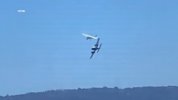Came along late in this one, but it’s a good discussion.
1. No such thing as partial blame. Doesn’t make sense at all. The person at fault is who had “last clear chance”, the twin. Period.
2. Now that’s cleared up, let’s go safety. Who was causal? EVERYONE. It isn’t always, but in this case it was. 3 main factors become evident to me:
A. Radio calls. Not required, not relevant. EXCEPT apparent trust in them. Hold that thought…
B. Manner in which operated. Nothing illegal here, not relevant. EXCEPT the “careless manner” clause. Hold that thought.
C. VISUAL SCAN. This is primary and trumps EVERYTHING else. Focus here is most relevant to preventing future similar occurrences.
To wit:
Reliance on radio calls being prioritized over establishing VISUAL CONTACT. I’m an electrician. Code say green wires aren’t hot. I DONT GRAB THEM WITHOUT CHECKING!!
Was the twin operating carelessly? Ya. But not illegally. Everyone has different definitions of straight in, reasonable approach speed, EVERYTHING. That’s why it’s important TO SEE THEM. Trust them, fine, BUT VERIFY!! Do you REALLY want EVERYTHING standardized? That’s called IFR….
Going forward. Don’t muddy this up with distractors. The twin failed to maneuver to avoid the collision.
Other causal factors worth discussion, but THAT was the final chance to avoid the mishap. And it fits. I know of other mishaps where it was the lead aircraft’s fault, not this one.

